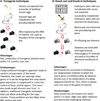Recent advances in gene manipulation and nicotinic acetylcholine receptor biology
- PMID: 21704022
- PMCID: PMC3162071
- DOI: 10.1016/j.bcp.2011.06.014
Recent advances in gene manipulation and nicotinic acetylcholine receptor biology
Abstract
Pharmacological and immunological methods have been valuable for both identifying some native nicotinic acetylcholine receptor (nAChR) subtypes that exist in vivo and determining the neurobiological and behavioral role of certain nAChR subtypes. However, these approaches suffer from shortage of subtype specific ligands and reliable immunological reagents. Consequently, genetic approaches have been developed to complement earlier approaches to identify native nAChR subtypes and to assess the contribution of nAChRs to brain function and behavior. In this review we describe how assembly partners, knock-in mice and targeted lentiviral re-expression of genes have been utilized to improve our understanding of nAChR neurobiology. In addition, we summarize emerging genetic tools in nAChR research.
Copyright © 2011 Elsevier Inc. All rights reserved.
Figures



Similar articles
-
Insights into the neurobiology of the nicotinic cholinergic system and nicotine addiction from mice expressing nicotinic receptors harboring gain-of-function mutations.Pharmacol Rev. 2012 Oct;64(4):869-79. doi: 10.1124/pr.111.004671. Epub 2012 Aug 10. Pharmacol Rev. 2012. PMID: 22885704 Free PMC article. Review.
-
Diversity of native nicotinic receptor subtypes in mammalian brain.Neuropharmacology. 2015 Sep;96(Pt B):302-11. doi: 10.1016/j.neuropharm.2014.11.003. Epub 2014 Nov 25. Neuropharmacology. 2015. PMID: 25460185 Review.
-
Physical and virtual screening methods for marine toxins and drug discovery targeting nicotinic acetylcholine receptors.Expert Opin Drug Discov. 2013 Oct;8(10):1203-23. doi: 10.1517/17460441.2013.822365. Epub 2013 Aug 6. Expert Opin Drug Discov. 2013. PMID: 23919818 Review.
-
Structural differences determine the relative selectivity of nicotinic compounds for native alpha 4 beta 2*-, alpha 6 beta 2*-, alpha 3 beta 4*- and alpha 7-nicotine acetylcholine receptors.Neuropharmacology. 2010 Jun;58(7):1054-66. doi: 10.1016/j.neuropharm.2010.01.013. Epub 2010 Jan 28. Neuropharmacology. 2010. PMID: 20114055 Free PMC article.
-
Naturally-expressed nicotinic acetylcholine receptor subtypes.Biochem Pharmacol. 2011 Oct 15;82(8):800-7. doi: 10.1016/j.bcp.2011.07.067. Epub 2011 Jul 20. Biochem Pharmacol. 2011. PMID: 21787755 Free PMC article. Review.
Cited by
-
Cotinine conundrum--a step forward but questions remain.J Natl Cancer Inst. 2012 May 16;104(10):720-2. doi: 10.1093/jnci/djs211. Epub 2012 Apr 25. J Natl Cancer Inst. 2012. PMID: 22534783 Free PMC article. No abstract available.
-
Nicotine inhibits memory CTL programming.PLoS One. 2013 Jul 2;8(7):e68183. doi: 10.1371/journal.pone.0068183. Print 2013. PLoS One. 2013. PMID: 23844169 Free PMC article.
-
AAV-directed persistent expression of a gene encoding anti-nicotine antibody for smoking cessation.Sci Transl Med. 2012 Jun 27;4(140):140ra87. doi: 10.1126/scitranslmed.3003611. Sci Transl Med. 2012. PMID: 22745437 Free PMC article.
-
Bridging the clinical gaps: genetic, epigenetic and transcriptomic biomarkers for the early detection of lung cancer in the post-National Lung Screening Trial era.BMC Med. 2013 Jul 19;11:168. doi: 10.1186/1741-7015-11-168. BMC Med. 2013. PMID: 23870182 Free PMC article. Review.
-
Neurochemistry: Lighting up with azobenzenes.Nat Chem. 2012 Jan 24;4(2):75-7. doi: 10.1038/nchem.1255. Nat Chem. 2012. PMID: 22270639 No abstract available.
References
-
- Chang CC, Lee CY. Isolation of neurotoxings from the venom of Bungarus multicinctus and their modes of neuromuscular blocking action. Arch Int Pharmacodyn Ther. 1963;144:241–257. - PubMed
-
- Schmidt J. Biochemistry of nicotinic acetylcholine receptors in the vertebrate brain. Int Rev Neurobiol. 1988;30:1–38. - PubMed
-
- Yamamoto KI, Domino EF. Nicotine-induced EEG and behavioral arousal. Int J Neuropharmacol. 1965;4:359–373. - PubMed
Publication types
MeSH terms
Substances
Grants and funding
LinkOut - more resources
Full Text Sources
Other Literature Sources

